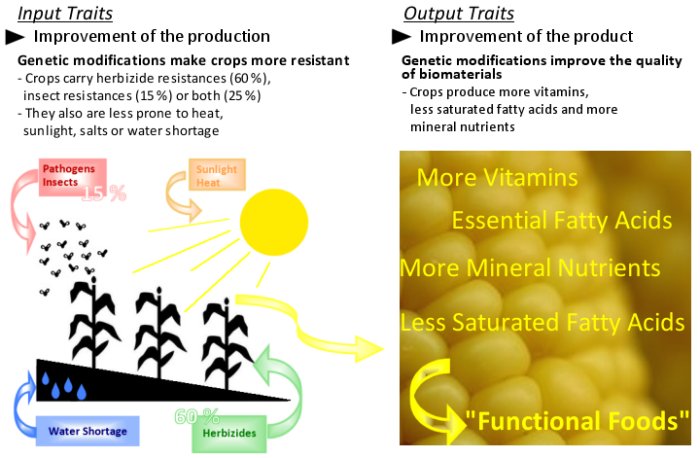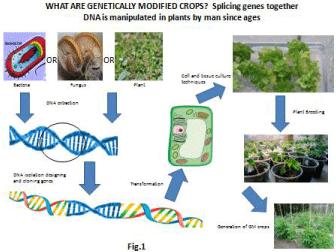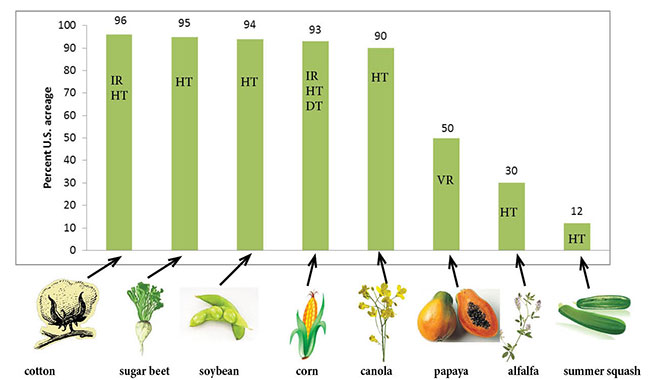Describe the Most Common Desired Traits Used in Gm Crops
Increased Flavor and Nutrition Along with resistances to insects and disease the genes of the crops can also be altered to have a better flavor and increased nutritional value. Only a few types of GMO crops are grown in the United States but some of these GMOs make up a large percentage of the crop grown eg soybeans corn sugar beets canola and cotton.
Genetically Modified Crops Water For All
In the USA 93 of soybeans and most of the GM maize grown is glyphosate tolerant.
. The majority of these species contain genes that make them either tolerant to herbicides or resistant to insects. With genetic engineering more than. See Table 1 To date the two most prevalent GM crops traits are Btderived insect resistance and herbicide resistance.
GM crops grown in Colorado include corn alfalfa sugar beet soybeans and canola. GM plants are much more common than many people realize too. Soybeans increased oleic acid have been also studied recently.
Insect resistant maize cotton potato and rice. That is a genetically heterogeneous population of plants is inspected and superior individualsplants with the most desired traits such as improved palatability and yieldare selected for continued propagation. These benefits are a plus for both farmers and consumers.
These crops are not available at this time but could be available in the near future. These plants have been modified in the laboratory to enhance desired traits such as increased resistance to herbicides or improved nutritional content. This was the main goal of GMO crops in the first place.
Genetically modified crops engineered to resist herbicides are now more available than conventionally bred resistant varieties. Overall however farmers reduced pesticide spraying by 776 million kilograms or 86 percent between 1996-2018 by adopting GM crops with insect-resistant IR and herbicide-tolerant HT traits. Another category of GE crop traits is improved nutritional content or health benefits.
Genetically engineered crops produce higher yields have a longer shelf life are resistant to diseases and pests and even taste better. This involves traditional breeding methods by which sufficient genetic variations are produced for the desired trait in crops such as high content of any micronutrient. Despite such discord genetically modified GM crops have the fastest adoption rate of any new technology in global agriculture simply because farmers benefit directly from higher yields and lowered production costs.
Largest acreage GM crops. It involves crossing varieties over many generations to ultimately yield a plant with high nutrient content along with other favourable traits. This is equal to more than 16 times Chinas total crop protection product use each year.
By making this toxin the corn is. Genetic engineering has. Here is a list of the 10 most common GMO foods so you can be more aware while grocery shopping.
GM crops with higher nutrient content eg. About 1917 million hectares was planted in 2018 to transgenic crops with high market value such as herbicide tolerant soybean maize cotton and canola. Other common traits include virus resistance delayed ripening modified flower colour or altered composition.
Genetically modified soybeans corn and other crops are used to make the ingredients eg flour cornmeal oils for a variety of processed foods such as breads cereals dairy products hot dogs snacks and soda. Resistance to insect damage. Transgenic crops have been planted in different countries for twenty years starting from 1996.
Up to 90 of soybeans in the market have been genetically modified to be naturally resistant to an herbicide called Round Up. For example one of the most common GMO crops is Bt corn which is genetically modified to produce the insecticide Bt toxin. Types of Genetic Modification Methods for Crops.
The majority of GM crops have been modified to be resistant to selected herbicides usually a glyphosate or glufosinate based one. Up to 24 cash back The term GM foods or GMOs genetically-modified organisms is most commonly used to refer to crop plants created for human or animal consumption using the latest molecular biology techniques. As a result farmers who grow GM crops have reduced the.
Examples of GM crops include corn varieties containing a gene for a bacterial pesticide that kills larval pests and soybeans with an inserted gene that renders them resistant to weed-killers such as Roundup. GM crops available on the international market today have been designed using one of three basic traits. Genetically modified plants may also be used as animal feed or for non-food purposes eg starch potatoes or cotton.
Examples are purple tomatoes and pink grapefruit with increased levels of antioxidants and golden rice which is engineered to reduce vitamin A deficiency. In 2014 28 countries grew GM crops and 39 countries imported but did not grow them. Among other things enables scientists to copy a gene with a desired trait in one organism and put it into another.
Genetically Modified GM crops offer improved yields enhanced nutritional value longer shelf life and resistance to drought frost or insect pests. The current generation of GM crops commercialised worldwide mostly have production-enhancing characteristics such as herbicide tolerance and insect resistance. Potential future applications of the technology include nutritional enhancements stress tolerance disease resistance biofuel efficiency and remediation of polluted sites.
Longer Shelf Life Genetically modified foods have a longer shelf life. Resistance to viral infections. And tolerance towards certain herbicides.
GM crops are regulated at the federal level by the US. Genetically modified GM plant in the early 1980s modern biotechnology has been used as a tool to develop new varieties of plants with desirable characteristics. The Golden rice is one of the oldest GM crops in the world and the last one on our list of 10 examples of genetically modified foods with full.
This is good all around. Today approximately 90 percent of the corn soybeans and sugar beets on the market are GMOs. And virus resistant squash and papaya.

Gm Crops Education Chemistryviews

Genetically Modified Gm Crops A Potential Source To Combat Global Hunger And Malnutrition

Genetically Modified Gm Crops Techniques And Applications 0 710 Extension

Comments
Post a Comment